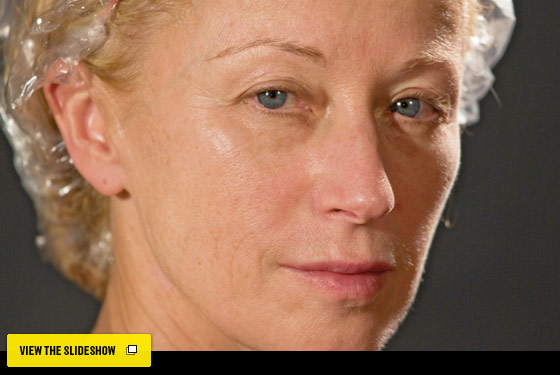 |
Cecil Beaton once said that “making oneself a work of art” was “that most difficult of all causes.” Cindy Sherman not only does that, she’s given herself up entirely to the mission. For nearly four decades, she has been braiding together fashion, photography, and the strange internal magic of herself—dressing up, putting on makeup, doing her hair, donning wigs, and posing alone in her studio for the camera. She shows us fashion as costume, compulsion, camp, ritual, and necessity. We see the ways fabric and cosmetics touch our bodies in public and how these performances of self make us visible, invisible, awful, sublime. Fashion helps Cindy hide in plain sight; in turn, she plays havoc with fashion. She is our greatest female impersonator.
A lot of people still think caring about clothes is a dubious, unserious, frivolous, girlie thing. Waves of academic critics have insisted, and still insist, that Sherman’s work is all about “the male gaze,” “the objectification of women,” and other such doctrinaire tropes. Sherman is most definitely an artist who thinks about gender roles, but she claims total ignorance of those rigid categorizations. “I was totally unaware of that,” she says. “I was trying to come to terms with my own ambivalence about liking to put makeup on … dressing up … [It] was a guilty pleasure … [that] allowed me to play around with makeup and the sexier, old-fashioned styles.” She has talked about being “inspired by how things are made, by fashion as art form.” She’s shot for Vogue, Harper’s Bazaar, and now the fashion issue of this magazine. She’s been commissioned by Comme des Garçons and Balenciaga.
Yet fashion alone doesn’t explain this most complexly uncanny American artist. Sherman delights in the mortification of the self, reveling in it like an epicurean at dinner; I see her as a spawn of De Sade and Rabelais, Daumier and Hogarth. Her survivalist instinct and relentless inventiveness make her a modern-day Scheherazade. Sherman’s art is that of someone saving her own life in a mostly male art world, working from deep instinct, ferocious imagination, assertion, self-defense, all while fashioning an elaborate tapestry of grand visors, demon clowns, Beau Brummels, and Valkyries; frazzled club girls, crinolined courtesans, dandies, macaronis, hippie chicks in Hiawatha fringe, Hollywood housewives, and other women fighting for their places in the world. Sherman is a warrior artist—one who has won her battles so decisively that I can’t imagine anyone ever again embarking on a lifetime of self-portraiture without coming up against her.
The definitive retrospective of Sherman’s work opens at the Museum of Modern Art on February 26. That makes this a good time for me to admit that I came late to a full appreciation of it. After being beguiled by her “Untitled Film Stills” in 1980—those are the photos that made her famous, in which she imagined herself as a series of anonymous mid-century actresses in mysterious frozen moments—I was baffled when Sherman became the princess of postmodernism, the artist who launched a thousand theories. For a decade I was cold on her art. The so-called “centerfolds” from 1981 and 1982—horizontal pictures of Sherman under sheets or waiting by the phone—and the lurid scenes that followed struck me as pictorially dull. It was obvious noir, New Wave negativity, overconstructed self-consciousness, I thought; it oozed sleepwalking eighties hipness.
Even then, though, I always liked one thing: She consistently asserted that her pictures weren’t self-portraits. “I really don’t think they’re about me,” she said. For a moment in 1985, in a series referred to as “fairy tales,” I glimpsed the dazing power of this distinction. In these pictures, Sherman’s solitude mutated into riskier, more unnerving images of otherness and self-inflicted psychic wounds. We saw Sherman posed as a survivor crawling on a fake beach, a hobgoblin in a field, a banshee wearing a turban and artificial breasts (“I collect breasts,” she says), gaping at us from the undergrowth, posed with her prosthetic ass facing the camera. Her work was in seizure. So was my judgment of it. But then she reverted to her melancholy doom, photographing postapocalyptic debris fields, vomit, and other abstract spinoffs. I was done with her. For good.
That changed the night of January 6, 1990. That evening, at the opening of her “history portraits” at her longtime gallery Metro Pictures, I saw Sherman explode her own formula. She not only aped the aura, ambience, and look of old-master paintings, lauding and marauding at the same time—she turned the so-called gaze of male painters and art history into an onslaught of undoing. Wearing brocade gowns, silken cravats, and frills of old, she was in front of and behind the camera, as director, model, artist, inquisitor, subject, costume designer, and disenfranchised human doll. A new female male old master, she posed as a bearded scholar, a dandy, a hag with pendulous fake breasts, a blonde squirting milk from a prosthetic nipple. Backgrounds, clothing, makeup, and props got richer; picture sizes, lighting, textures, pattern, and palette intensified. It was riveting.

